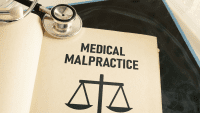Introduction
Emergency nurses work in tumultuous environments where acuity and volumes are high, waiting rooms are overcrowded, and time is of the essence. Due to the variety of patients and diagnoses served in the emergency department (ED), nurses must be aware of important legal considerations inherent to emergency nursing. This article presents legal considerations for ED nurses.
EMTALA
Nurses working in emergency settings must be familiar with the Emergency Medical Treatment and Labor Act (EMTALA). EMTALA violations are often directed toward physicians and hospitals; however, in emergency departments, nurses are the first point of contact patients meet in emergencies (Schultz et al., 2024). Failure to complete a medical screening exam, stabilize, arrange transfer, accept transfer, and respond to on-call situations are examples of EMTALA violations (2024). Violations may lead to civil monetary penalties, loss of Medicare certification, and potential legal action against the individual nurse or healthcare facility. These include but are not limited to patients presenting within 250 yards of the main or principal building, patients in a hospital-owned ambulance, and patients deemed to not have an emergency medical condition.
Obstetric Care
EDs are well-equipped to treat obstetric emergencies, including vaginal bleeding, premature labor, and other urgent obstetric concerns. Obstetric care in the ED often involves a collaborative approach between emergency medicine and obstetric teams to ensure the best outcome for the mother and the baby. Once obstetric conditions are stabilized, patients are referred for ongoing specialized services.
ED nurses have reported significant knowledge gaps regarding obstetric care and legal implications (Kusterbeck, 2024). Nonetheless, obstetric care is becoming more common in emergency settings as options for reproductive rights change throughout the United States (Wolf et al., 2023). EDs are required to provide emergency services, including abortion care for women with life-threatening pregnancy complications (2024). The concern lies in states where abortion is illegal, as pregnant women present to EDs regardless of whether they have obstetric care or not.
Blood Alcohol Draws
ED nurses are charged with maintaining patient autonomy and reporting public health hazards (Tessier & Keegan, 2019). Regarding blood alcohol draws, patient consent ultimately governs the decision-making process for nurses. Legal barriers to alcohol screening in the ED can include issues related to patient consent, privacy rights, and compliance with local regulations. Additionally, respecting patient confidentiality is vital, and disclosure of alcohol-related information is subject to strict privacy laws. Hospitals should educate providers and nurses on applicable laws and clarify state and institutional policies on mandatory blood draws (2019).
Mental Health
EDs often have limited resources to treat patients with mental health conditions, and not all ED nurses have received specialized training in mental health. This lack of training and a stigma surrounding mental health can contribute to misunderstanding and inadequate care. Offering crisis intervention training programs that focus on crisis intervention techniques, de-escalation strategies, and recognizing signs of mental health crises can help to identify and properly handle situations that may arise when taking care of patients suffering from a mental health crisis. ED nurses can enhance communication skills by actively listening, having empathy, and using non-judgmental communication with these patients (Navas et al., 2022). In addition, fostering collaboration with mental health professionals, social workers, and psychiatrists can help to provide comprehensive care to patients with mental health concerns.
Most importantly, EDs can develop protocols for conducting thorough risk assessments for patients presenting with mental health concerns, including suicide/ homicide risk assessment, and provide ongoing education and access to resources related to mental health conditions, treatment options, and community support services. Lastly, facilitating appropriate follow-up care and referrals for patients discharged from the ED with mental health needs and ensuring continuity of care beyond the emergency setting can help to facilitate adequate care. By implementing these recommendations, ED nurses can provide effective and compassionate care to individuals experiencing mental health challenges in the emergency setting.
Conclusion
ED nurses are at the forefront of emergency care. As such, ED nurses have a broad scope of practice and, therefore, must understand the legal implications of emergency care. To that end, ED nurses must meticulously document their interventions, adhere to policies and procedures, and effectively communicate with interdisciplinary teams. Education and training on patients who present with specialized circumstances, including mental health and obstetric emergencies, may reduce legal implications for ED nurses.
References
Kusterbeck, S. (2024). ED nurses lack knowledge of legal implications of OB cases. ED Management, 36(1), 1–16.
Navas, C., Wells, L., Bartels, S. A., & Walker, M. (2022). Patient and provider perspectives on emergency department care experiences among people with mental health concerns. Healthcare (Vol. 10, No. 7, p. 1297).
Schultz, T. R., Forbes, J., & Packard, A. H. (2024). Emergency Medical Treatment and Labor Act: Impact on health Care, nursing, quality, and safety. Quality Management in Health Care, 33(1), 39–43. https://doi.org/10.1097/QMH.0000000000000438
Tessier, W., & Keegan, W. (2019). Mandatory blood testing: When can police compel a health provider to draw a patient’s blood to determine blood levels of alcohol or other intoxicants? Missouri Medicine, 116(4), 274–277.
Wolf, L., Noblewolf, H. S., Callihan, M., & Moon, M. D. (2023). What if it were me? A qualitative exploratory study of emergency nurses’ clinical decision making related to obstetrical emergencies in the context of a post-roe environment. Journal of Emergency Nursing, 49(5), 714-723. https://doi.org/10.1016/j.jen.2023.06.009

























